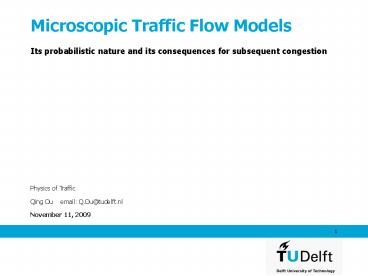Microscopic Traffic Flow Models - PowerPoint PPT Presentation
1 / 27
Title:
Microscopic Traffic Flow Models
Description:
Its probabilistic nature and its consequences for subsequent congestion. Physics of Traffic ... GHR Model well-known in late fifties and sixties ... – PowerPoint PPT presentation
Number of Views:1175
Avg rating:5.0/5.0
Title: Microscopic Traffic Flow Models
1
Microscopic Traffic Flow Models
- Its probabilistic nature and its consequences for
subsequent congestion
Physics of Traffic
Qing Ou email Q.Ou_at_tudelft.nl
2
Topics
- The earlier microscopic models (CA, CF)
- KKW model
3
Cellular Automaton (CA) Model
- Space is divided into cells
- Time is discrete
- Rules
- CA Models are used to described discrete
dynamical systems
4
1D CA Model for Microscopic Traffic
- Nagel Schreckenberg (NS) Model
- A road is divided into L cells numbered by 1,2L
- Time is discrete
- Vehicle with integer velocity v0,1,Vmax
5
Rules for NS Model
- Acceleration viltVmax, then vi? vi 1
- Slowing down if vigtdi then vidi, (dixi1-xi-1
and xi is the position of vehicle i ) - Stochastic deceleration with probability p,
vi(gt0)? vi -1 - Position updating xi? xi vi
- (Introduction of probability make it difficult
to get analytic solution to this model)
6
Fukui Ishibashi (FI) Model
- Velocity updating vi?min(di, Vmax)
- Position updating xi? xi vi
- An analytical relation between average velocity
and average density
7
Car Following (CF) Model
- Three main types
- GHR model
- Safety-distance model (Gipps model)
- Linear model
- Psycho-physical (e.g. GM models)
- Reactionfollowersensitivityfollowerstimulus
8
Car Following (CF) Model
- The basic ideas about car following model can be
summarized - The function represents the stimulus to the
vehicle, and this stimulus is composed by the
speed of the vehicle speed difference and gap
between the vehicle and the leading vehicle
9
Gazis-Herman-Rothery (GHR) model
- GHR Model well-known in late fifties and sixties
- which considers relative spacing and speeds
between vehicle n and n-1. - c, l, m are constants and T is driving
reaction time
10
Best combination of m and l regarding GHR model
- m0.8, l2.8 (May and Keller, 1967)
- m-0.8, l1.2 (Heyes and Ashworth, 1972) data
from Mersey tunnel in UK - m0.6 , l2.4 (Ceder and May, 1976) a far large
number of data sets - replaced by , S is jam
spacing and A valued from 0 to 10 indicating free
flow to congestion - Now seldom used for large number of contradictory
findings as to correct m and l.
11
Car Following (CF) Model
- Safety Distance Model
- Driver maintains a speed v which will just allow
him - to stop in emergency without hitting the obstacle
at - distance S ahead
12
Linear Model
- Acceleration
- Desired following distance
- Share the similar disadvantages with GHR model
13
Two Lane Model (Symmetry)
- The single lane model results in platooning with
slow vehicles followed by faster ones. - The most important elements of the two lane
model - Symmetry
- Stochasticity
- Direction of Causality
14
Basic rules for lane changing
- Look ahead if somebody is in your way
- Look on the other lane if it is any better there
- Look back on the other lane if you would get in
somebody elses way
15
Technical rule for lane changing
- T1 how far you look ahead on
your lane - T2 ahead on the other lane
- T3 back on the other
lane - T4
- When all conditions are satisfied, lane changing
16
The main parts of complete microscopic model
- Motion rules
- Lane changing rules
- Stochastic ingredients
17
Microscopic three-phase traffic theory (KKW Model)
- Earlier traffic flow theories and models are in a
serious conflict with many of these empirical
spatiotemporal traffic pattern features - Introduction of three-phase traffic theory to
explain all eimpirical spatiotemporal congested
pattern. - Free flow
- Synchronized flow
- Wide moving jam
18
Main rules in KKW Model
- Vehicle Motion rules
- Lane changing rules
- Random acceleration and deceleration rules
- The biggest feature in KKW model
- Synchronization distance (page 100)
- (E q16.29
page410)
19
Main rules in KKW Model
- Vehicle Motion rules
20
Main rules in KKW Model
- Lane changing rules
- Incentive conditions (Eq16.75 p420)speed
- Security conditions (Eq16.77 p421)gap
- depending on the function
21
Main rules in KKW Model
- Stochastic part of KKW model
22
Main behavioral model assumptions and model
parameters
- In synchronized flow, a driver accepts a range of
different hypothetical steady state speeds at the
same space gap to the preceding vehicle.
23
Main behavioral model assumptions and model
parameters
- A driver tends to adjust the speed to the
preceding vehicle within the synchronization
distance
24
Main behavioral model assumptions and model
parameters
- Over-acceleration effect
- It is responsible for an F?S transition and the
related Z-shaped dependence of vehicle speed on
density - The simulation of the vehicle over-acceleration
effect is made through the use of random vehicle
fluctuations - Over-Deceleration effect
- This random effect of the vehicle
over-deceleration is responsible for moving jam
emergence. - (Stochastic part of model, page 426)
25
Main behavioral model assumptions and model
parameters
- A driver in synchronized flow does not accelerate
before the preceding vehicle has begun to
accelerate. - Moving in synchronized flow, a driver comes
closer to the preceding vehicle over time that
explains the pinch effect in synchronized flow. - (Stochastic time delay of acceleration and
deceleration, page 426)
26
Conclusion
- Three-phase theory can explain empirical features
of phase transitions and congested patterns at
freeway bottlenecks. - Models based on this theory is formed by the
introduction of a synchronization distance - The synchronization distance depends on
time-dependent vehicle speeds. - Safety conditions, driver time delays, stochastic
behavior, lane changing rules should be well
adjusted
27
- Thank you!































